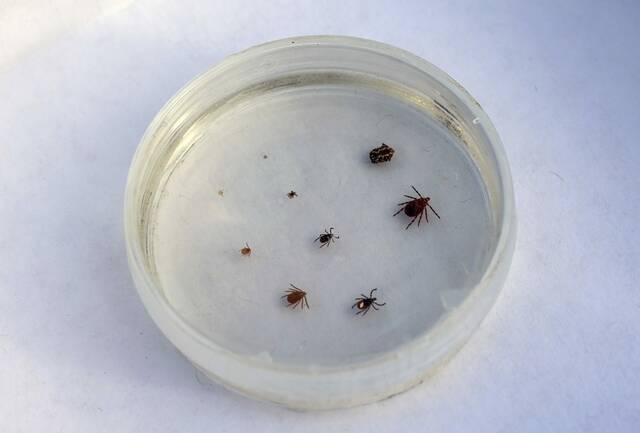Ticky business: How Pitt researchers track the 8-legged bloodsuckers
There’s nothing fancy about tick hunting.
When University of Pittsburgh professor Danielle Tufts and her team of public health students go out, they bring just a few things: A white jumpsuit, a pair of tweezers, some tiny vials to store specimens and a meter-long piece of white corduroy.
The cloth is dragged for 10 meters, then flipped over to see what ticks might have clung on. These little arachnids spend a majority of their lives waiting for a blood meal among the vegetation, and will latch on to any opportunity they get.
In just two swipes last week along a forested part of Schenley Park in Pittsburgh’s Squirrel Hill neighborhood, Tufts and doctoral student Emily Bache found around 20 invasive Asian longhorned ticks. Each was between the size of a pinprick and a poppy seed, making them nearly imperceptible from a standing position.
It’s a remarkably basic way to go about things.
“This is very technical,” Tufts kidded. “We drag the cloth behind us.”
Joking aside, tick-hunting is serious work. Ticks are not only thriving in places they’ve long called home like Pennsylvania, but they’re finding new frontiers in parts of the country that have grown more hospitable because of climate change. If a swelling army of parasitic creatures isn’t bad enough, they can transmit a host of diseases to people and pets, making careful monitoring all the more urgent.
Lyme disease is the most common, with almost 6,700 confirmed human cases in Pennsylvania so far this year. Compared to 2023 and 2024, which had nearly 17,000 cases each, the state is on track for a down year.
But several other illnesses are spread by the state’s tick population, like bacterial anaplasmosis and parasite-caused babesiosis.
Plenty of tickborne illnesses are relatively mild and treatable, if caught early. That’s a challenge, though, given ticks’ minuscule size and the nonspecific symptoms, like fever, chills and aches, that often accompany these diseases.
Even the telltale bullseye rash associated with Lyme disease doesn’t always show up.
A minority of people experience severe or long-term symptoms. Deaths are rare, but not unheard of.
Tufts and her team sometimes share findings with officials at the Allegheny County and state health departments, which do surveillance work of their own.
They’re also building an online map that shows the prevalence of ticks and tickborne diseases in parks across the region.
“What we’re trying to do with this study is … find some of those hot spots, so we can tell the people, ‘be careful, this is a very ticky area,’ ” Tufts said.
‘Tickier’ year
The Pennsylvania Tick Research Lab, which operates out of East Stroudsburg University, also does the cloth-and-tweezers operations in a few parts of northern Pennsylvania. Its primary focus, however, is testing ticks plucked off people and pets’ skin for various diseases. Within three business days of receiving the tick, the lab sends back results.
It also maintains an online dashboard of test results. More than 16,000 ticks have been analyzed for diseases so far this year, about 22% of which carried at least one pathogen. At the same point last year, only 12,000 or so ticks had been analyzed, with a 25% infection rate.
Bite reports sent to the tick lab are declining from an early-to-mid June peak. That reflects typical seasonal trends, according to experts.
Juvenile ticks, called nymphs, are most active between late April to early July. Diseases are most likely to be transmitted to hosts during this stage. Adults, which also can spread pathogens, are most active through fall and into winter.
But ticks can be out and about any time of year, noted Nicole Chinnici, director of the Pennsylvania Tick Research Lab.
“Even if there’s snow on the ground, if temperatures are warm enough, they’ll come out,” she said.
Here to stay
Researchers also look at what types of ticks are crawling around the state’s woodlands. For example, Schenley Park used to be the domain of deer ticks, also known as black-legged ticks. But in just a few years, the Asian longhorned tick became the dominant species as it fanned out across nearly half the U.S.
Their superpower is parthenogenesis, a process through which females reproduce without mating.
And ticks can lay anywhere from 2,000 to 3,000 eggs at once.
“This is why there’s probably no getting rid of ticks ever,” Tufts said.
Safeguards
If you’re going outside and worried about ticks, experts recommend wearing long sleeves and pants. Tucking the pants into socks also helps keep ticks at bay.
Repellents containing permethin, a chemical similar to a natural ingredient in chrysanthemums that makes ticks avoid the flowers, can add further protection. But be careful: Permethin can cause irritation if applied directly to the skin.
Once you’re back indoors, a tick check is in order. Pay extra attention to your armpits, hairline and anywhere that tends to be sweaty.
“If you do find one tick, with the abundance of ticks that we have, make sure you do a thorough tick check to make sure there’s not a potential second tick,” Chinnici said.
Any ticks discovered should be pulled up and out using tweezers. Crushing ticks can be a challenge because of their hard outer armor, plus it raises the risk of disease transmission.
Instead, drown them in rubbing alcohol, flush them down the toilet, wrap them in tape or, if you’re so inclined, send them for testing to the Pennsylvania Tick Research Lab or other services.
It’s worth noting the Centers for Disease Control and Prevention advises against tick testing as a way to guide treatment decisions.
After removing the tick, monitor yourself for a rash around the bite or flu-like symptoms. If either of these appear, seek medical care.
Tick safety with pets
Pets also are attractive to ticks. Around 16% of the bites reported to the Pennsylvania Tick Research Lab this year were in dogs and cats.
“I would definitely, especially if you live in a heavily wooded area, check your cats and dogs when they come back inside,” said Amy Kalinauskas, senior director of medical services for Humane Animal Rescue. “Because even if they have flea or tick medication, they can ride on top of the fur and they can transfer to a human or child inside.”
Signs of Lyme disease in pets include lethargy, decreased appetite and a limp that may switch legs day-to-day because of joint inflammation. In extreme cases, the infection can cause kidney failure.
Red areas on pets’ skin can also provide a clue they may have been bitten.
“I would recommend testing your animal at least once a year for tickborne illness and heart worms, so you don’t miss anything,” Kalinauskas said. “Sometimes animals don’t show any clinical signs, and then it’s too late.”
Jack Troy is a TribLive reporter covering business and health care. A Pittsburgh native, he joined the Trib in January 2024 after graduating from the University of Pittsburgh. He can be reached at
Remove the ads from your TribLIVE reading experience but still support the journalists who create the content with TribLIVE Ad-Free.








